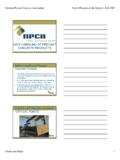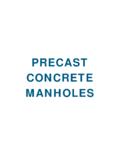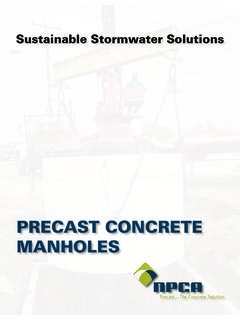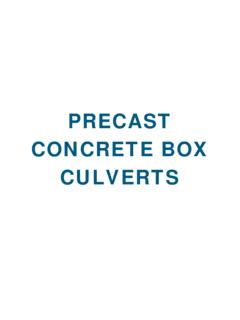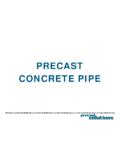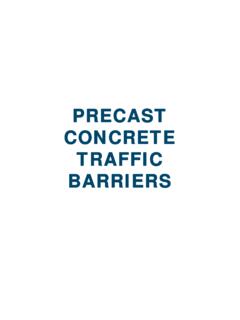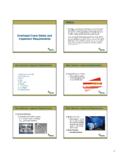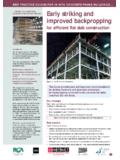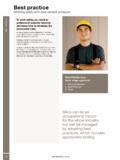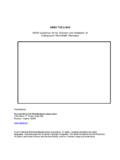Transcription of NATIONAL PRECAST CONCRETE ASSOCATION
1 Copyright 2006 by NATIONAL PRECAST CONCRETE Association (NPCA)Second Edition, 2005 All rights of this manual may be reproduced in any form without permission in writing fromthe NATIONAL PRECAST CONCRETE association of the manufactured CONCRETE products North Meridian Street, Suite 272 | Indianapolis, Indiana 46290800-366-7731 | 317-571-0041 (fax) | PRECAST CONCRETE manual does not claim or imply that itaddresses all safety-related issues, if any,associated with its use. Manufacture ofconcrete products may involve the use ofhazardous materials, operations andequipment. It is the user s responsibility todetermine appropriate safety, health andenvironmental practices and applicableregulatory requirements associated withthe use of this manual and the manufactureof CONCRETE Use of this manual does not guarantee theproper function or performance of anyproduct manufactured in accordance withthe requirements contained in the conformance to the requirementsof this manual should result in products ofan acceptable quality according to currentindustry CONCRETE is ideally suited for utility, industrial andcommunications structures.
2 A properly manufactured andinstalled PRECAST CONCRETE structure can last almostindefinitely. PRECAST CONCRETE is inherently durable, highlyimpermeable and , industrial and communications structures are animportant part of the manufactured CONCRETE productsindustry, and we must continue to provide project ownersand end users with the best possible products atcompetitive prices. It is also important that thoseproducts contribute to the quality, timeliness and ease ofinstallation of construction projects. The best practicesoutlined in this manual are intended to helpmanufacturers achieve these properly designed and manufactured, precastconcrete is capable of maintenance-free performancewithout the need for protective coatings, except in certaincircumstances such as highly-corrosive environments.
3 The PRECAST advantage is further solidified through PRECAST sease of installation and strength. Because precastconcrete products typically are produced in a controlledenvironment, they exhibit high quality and factors affecting quality which are typicallyfound on job sites variable temperature, uneven curingconditions, inconsistent material quality andcraftsmanship are significantly reduced in a CONCRETE products are important for manyapplications, most notably for underground structuresthat must resist soil pressures and sustain surface controlled manufacturing environment in a precastconcrete plant is ideal for the production of high-quality,durable CONCRETE manual is intended to guide manufacturers in qualityproduction processes for manufacturing utility vaults. Themanual is not intended to be all inclusive and therecommendations are not intended to exclude anymaterials or techniques that would help achieve the goalof providing structurally sound, high quality to detail, quality materials, proper training anda workforce dedicated to quality control will ensure thatthe utility vault meets or exceeds the expectations ofcontractors and end VAULT MANUFACTURING BEST PRACTICES MANUALSTRUCTURAL DESIGN4 NATIONAL PRECAST CONCRETE ASSOCATIONL oading ConditionsA properly designed PRECAST CONCRETE utility vault mustwithstand a variety of loading conditions, which varyduring manufacturing, installation, testing and structures are designed to withstand loadingconditions through rational mathematical designcalculations.
4 By proof-of-load testing or in accordancewith ASTM C 857 Standard Practice for MinimumStructural Design Loading for Underground PrecastConcrete Utility Structures. Consider the following in the design: Surface surcharge loads Concentrated wheel and other traffic loads Lateral loads Presumptive soil bearing capacity Buoyant forces Connections and penetrations Point loadsPrecast CONCRETE utility vaults should be designedaccording to one or more of the following industry codesand standards and as required by any regulatory groupswith jurisdiction: ACI 318 Building Code Requirements for StructuralConcrete AASHTO Specification for Highway Bridges ASTM C 857 Standard Practice for MinimumStructural Design Loading for Underground PrecastConcrete Utility Structures ASTM C 858 Standard Specification for UndergroundPrecast CONCRETE Utility StructuresThe loading conditions illustrated in the diagram(s)should be analyzed and considered in the design of autility following design characteristics have a critical impacton the performance of utility ThicknessThe CONCRETE thickness must be sufficient to meetminimum reinforcement cover requirements and withstanddesign loading Mix Design CONCRETE must have a minimum compressive strength of4,000 psi at 28 days.
5 Consider methods to reducepermeability, improve durability and increase a low water-cementitious ratio at or below Proper design and placement is critical to withstand thesignificant loads applied to utility vaults. Reinforcementmust be sufficient for required strength and serviceconditions, including temperature and shrinkage cracking by using multiple small-diameter steelbars rather than fewer large-diameter steel bars. Fiberreinforcement also helps to reduce cracking and may addsome strength, but should not replace primaryreinforcement. Welded-wire reinforcement can also beused, but particular attention should be paid to designand location. All reinforcement should meet applicableASTM Diagram*Manufacturer to specify the maximum depth of coverTop SeamVaultGrade lineGroundwater Level++Mid-SeamVaultResidential Soil Residential Soil Depth ofCoverHydrostatic LoadingSoil LoadingHydrostatic LoadingSoil LoadingSurchargeSurchargeMATERIALSThe primary constituents of PRECAST CONCRETE are cement,fine and coarse aggregates, water and admixtures.
6 Thefollowing discussion covers relevant factors in theselection and use of these fundamental The majority of cement used in the manufacturedconcrete products industry is governed by ASTM C 150, Standard Specification for Portland Cement. The five primary types of ASTM C 150 cement are:Type I NormalType II Moderate Sulfate ResistanceType III High Early StrengthType IV Low Heat of HydrationType V High Sulfate ResistanceSelect the cement type based on project specifications orindividual characteristics which best fit the operation andregional conditions of each manufacturer. Note thatcertain types of cement may not be readily available incertain regions. Store cement in a manner that willprevent exposure to moisture or other cement should be stored in watertight bins or different types of cement are used at a facility, storeeach type in a separate bin or silo.
7 Clearly identifydelivery and maintain bin and silo compartments todischarge freely and independently into the weighinghopper. Cement in storage should be drawn downfrequently to prevent undesirable caking. Stack baggedcement on pallets to permit proper air circulation and toavoid undesirable moisture and condensation. On a short-term basis (less than 90 days), stack the bags no morethan 14 high. For long-term storage, do not exceed sevenbags in height (or per manufacturer s recommendations).Use the oldest stock first. Discard any cement with lumpsthat cannot be reduced by finger Ensure aggregates conform to the requirements of ASTMC33, Standard Specification for CONCRETE Aggregates. Evaluate the aggregates and maintain documention at theplant for potential deleterious expansion due to alkalireactivity, unless the aggregates come from a statedepartment of transportation-approved source.
8 Themaximum size of coarse aggregate should be as large aspractical, but should not exceed 20 percent of theminimum thickness of the PRECAST CONCRETE utility vault or75 percent of the clear cover between reinforcement andthe surface of the vault. Larger maximum sizes ofaggregate may be used if evidence shows thatsatisfactory CONCRETE products can be are an important constituent of precastconcrete utility vaults. Nearly 75 percent of a precastconcrete utility vault s structure consist of coarse andfine selection of appropriate aggregates is largely aregional concern. The selection process is based on usingthe best available clean, hard, durable aggregates andproper gradations. Aggregates should conform to ASTMC 33 Standard Specification for CONCRETE Aggregatesand ACI 318 Building Code Requirements for of Aggregates CONCRETE is exposed to continuous moist and potentiallycorrosive conditions in underground , two important selection parameters are theaggregate s expansive properties when exposed tomoisture and its porosity.
9 It is important to specify awell-graded, sound, nonporous aggregate in accordancewith ASTM C33 Standard Specification for ConcreteAggregates. This should be executed with limitedamounts of materials that are deleteriously reactive withthe alkalis in cement. When receiving aggregate from anarea known to have potential problems with alkali-aggregate reaction, alkali-silica reaction or alkali-carbonate reaction, the aggregate supplier should providesufficient laboratory data on the aggregate s VAULT MANUFACTURING BEST PRACTICES MANUALIf the only available aggregates in your area have beenfound to cause excessive expansion of mortar orconcrete, appropriate precautionary measures should betaken during the mix design process. The use of mineraladmixtures, a low water-cement ratio or a low-alkalicement can all aid in controlling such expansivereactions.
10 When using mineral admixtures or a low-alkalicement, trial batches should be tested to establish theirviability in controlling the expansive reactions. Gradation of Aggregates Aggregate gradation influences both the economy andstrength of a finished utility vault. The purpose of propergradation is to produce CONCRETE with a maximum densityalong with good workability to achieve aggregates help improve workability,durability and strength of the CONCRETE . Poorly graded orgap-graded aggregates rely on the use of excess mortarto fill voids between coarse aggregates, leading topotential durability problems. CONCRETE mixes containingrounded coarse aggregates tend to be easier to place andconsolidate. However, crushed aggregates clearly areacceptable. The use of elongated, flat and flakyaggregates is discouraged.
